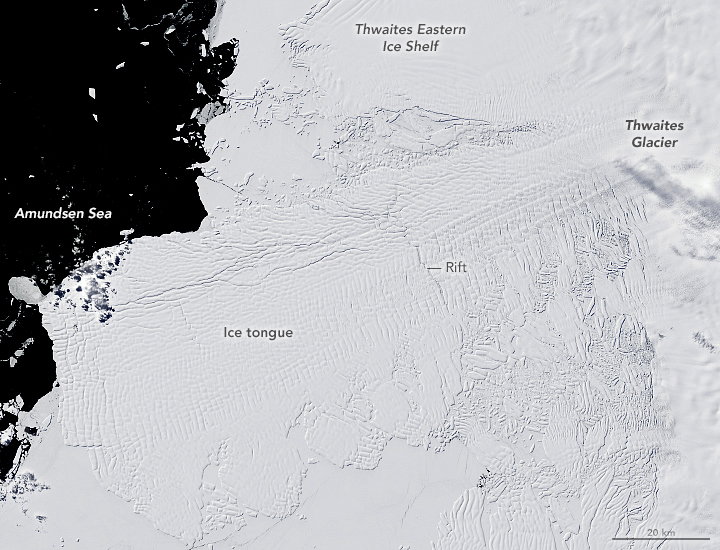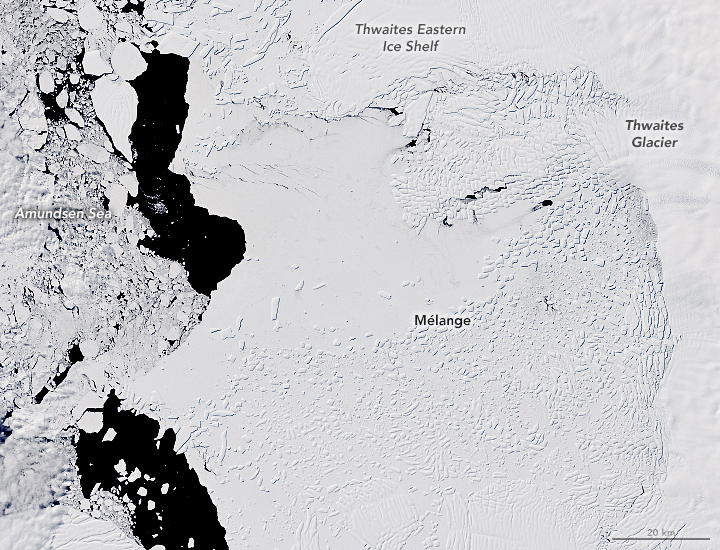

Thwaites Glacier Transformed
Downloads
- thwaites_ls7_2001336_lrg.jpg (9818x7500, JPEG)
- thwaites_oli_2019362_lrg.jpg (7854x6000, JPEG)
Metadata
- Sensor(s):
- Data Date: December 28, 2019
- Visualization Date: February 4, 2020
Antarctica’s Thwaites Glacier has been in the spotlight in recent years, as scientists have undertaken a multi-part international project to study the vast glacier from all angles. The urgency stems from observations and analyses showing that the amount of ice flowing from Thwaites—and contributing to sea level rise—has doubled in the span of three decades. Scientists think the glacier could undergo even more dramatic changes in the near future.
This image pair demonstrates the changes that have occurred since the start of this century. The first image, acquired with the Enhanced Thematic Mapper Plus (ETM+) on Landsat 7, shows the glacier’s floating ice tongue on December 2, 2001 shortly before it calved Iceberg B-22. The second image, acquired with the Operational Land Imager (OLI) on Landsat 8, shows the glacier on December 28, 2019.
Both images show the glacier where it exits the land in West Antarctica and stretches over the Amundsen Sea as thick floating ice. Ice that originates on land can raise sea level if it is delivered to the ocean at a faster rate than it is being replaced inland by snowfall. Indeed, Thwaites Glacier is one of the largest contributors to global sea level rise from the West Antarctic Ice Sheet. The flow speed of Thwaites has been increasing, while inland snowfall has not changed significantly.
Notice the size of the glacier’s main ice tongue in 2001, when the glacier was advancing by about 4 kilometers per year. The large rift across the glacier eventually spawned Iceberg B-22 in 2002.
In the past ten years, the tongue has continued to fracture and separate from the Thwaites Eastern Ice Shelf. By the time the 2019 image was acquired, the main tongue had retreated substantially, and the ocean in front of Thwaites had become filled with mélange, a mixture of icebergs and sea ice.
Unlike Pine Island Glacier—which tends to shed large icebergs every few years (now almost annually)—the icebergs that now break from Thwaites are generally not large enough to be named and tracked by the U.S. National Ice Center. Instead, the glacier is constantly producing many small broken bits.
The melting of floating ice as it makes contact with the ocean is a key reason why the glacier is coming unglued. Seawater that is a few degrees above freezing is melting the ice shelf from below. Warm water has recently been recorded near the Thwaites Glacier grounding line—the location where the glacial ice rests on the seafloor.
“What the satellites are showing us is a glacier coming apart at the seams,” said Ted Scambos, a senior scientist at the University of Colorado. “Every few years a new area seems to be letting go and accelerating. Like taffy being stretched out, this glacier is being drawn into the ocean.”
References and Further Reading
- BBC News (2020, January 28) Antarctica melting: Climate change and the journey to the ‘doomsday glacier.’ Accessed February 5, 2020.
- Eos (2020, January 10) Controlled Explosions Pave the Way for Thwaites Glacier Research. Accessed February 5, 2020.
- International Thwaites Glacier Collaboration (2020) About the ITGC. Accessed February 9, 2020.
- International Thwaites Glacier Collaboration (2018, April 30) UK and US join forces to understand how quickly a massive Antarctic glacier could collapse. Accessed February 5, 2020.
- Joughin, I. et al. (2014) Marine Ice Sheet Collapse Potentially Under Way for the Thwaites Glacier Basin, West Antarctica. Science, 344 (6185), 735-738.
- Live Science (2020, January) Scientists Are Racing to Figure Out Why This Giant Glacier in Antarctica Is Melting So Fast. Accessed February 5, 2020.
- Milillo, P. et al. (2019) Heterogeneous retreat and ice melt of Thwaites Glacier, West Antarctica. Science Advances, 5 (1).
- Nakayama, Y. et al. (2019) Pathways of ocean heat towards Pine Island and Thwaites grounding lines. Scientific Reports, 9 (16649).
- Scambos, T.A. et al. (2017) How much, how fast?: A science review and outlook for research on the instability of Antarctica’s Thwaites Glacier in the 21st century. Global and Planetary Change, 153 (2017), 16-34.
- Yu, H. et al. (2019) Impact of Iceberg Calving on the Retreat of Thwaites Glacier, West Antarctica Over the Next Century With Different Calving Laws and Ocean Thermal Forcing. Geophysical Research Letters, 46 (24), 14539-14547.
NASA Earth Observatory images by Lauren Dauphin, using Landsat data from the U.S. Geological Survey. Story by Kathryn Hansen, with image interpretation by Christopher Shuman (NASA/UMBC) and Ted Scambos (University of Colorado).
This image record originally appeared on the Earth Observatory. Click here to view the full, original record.